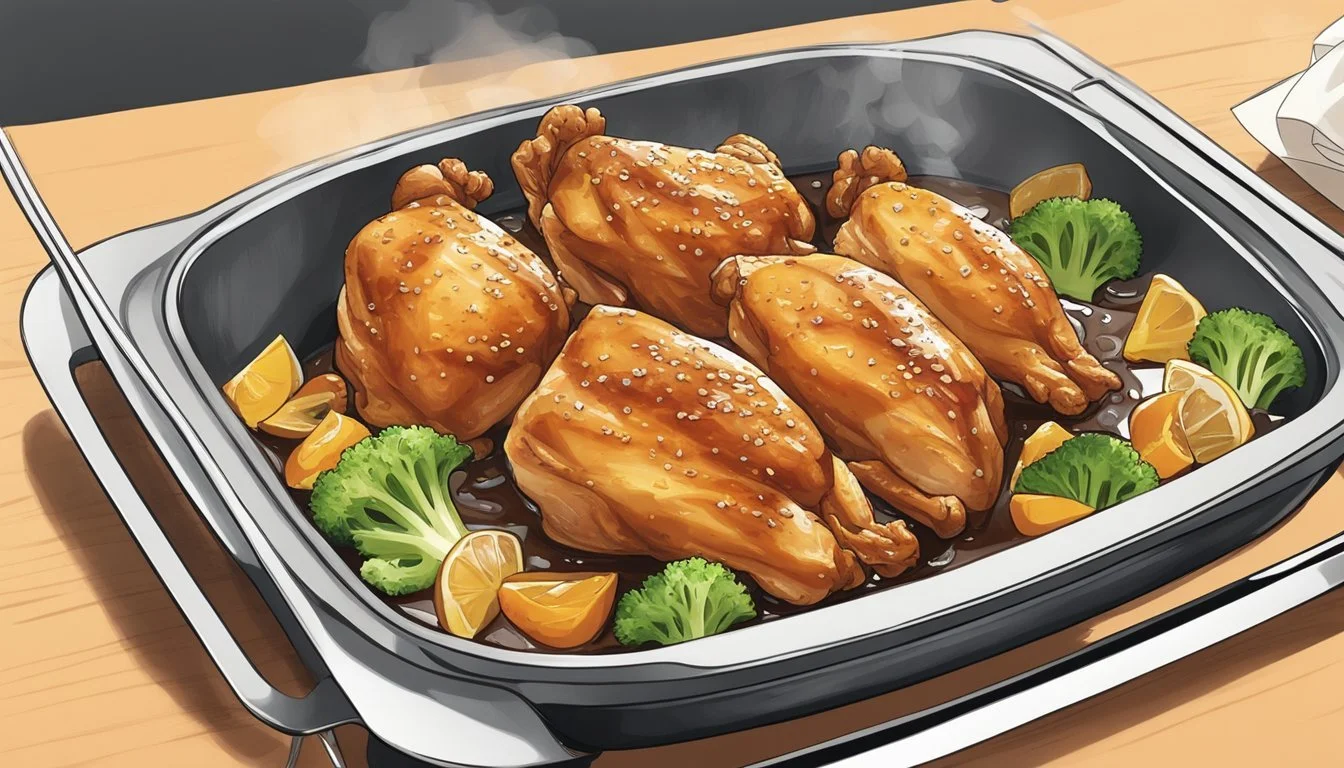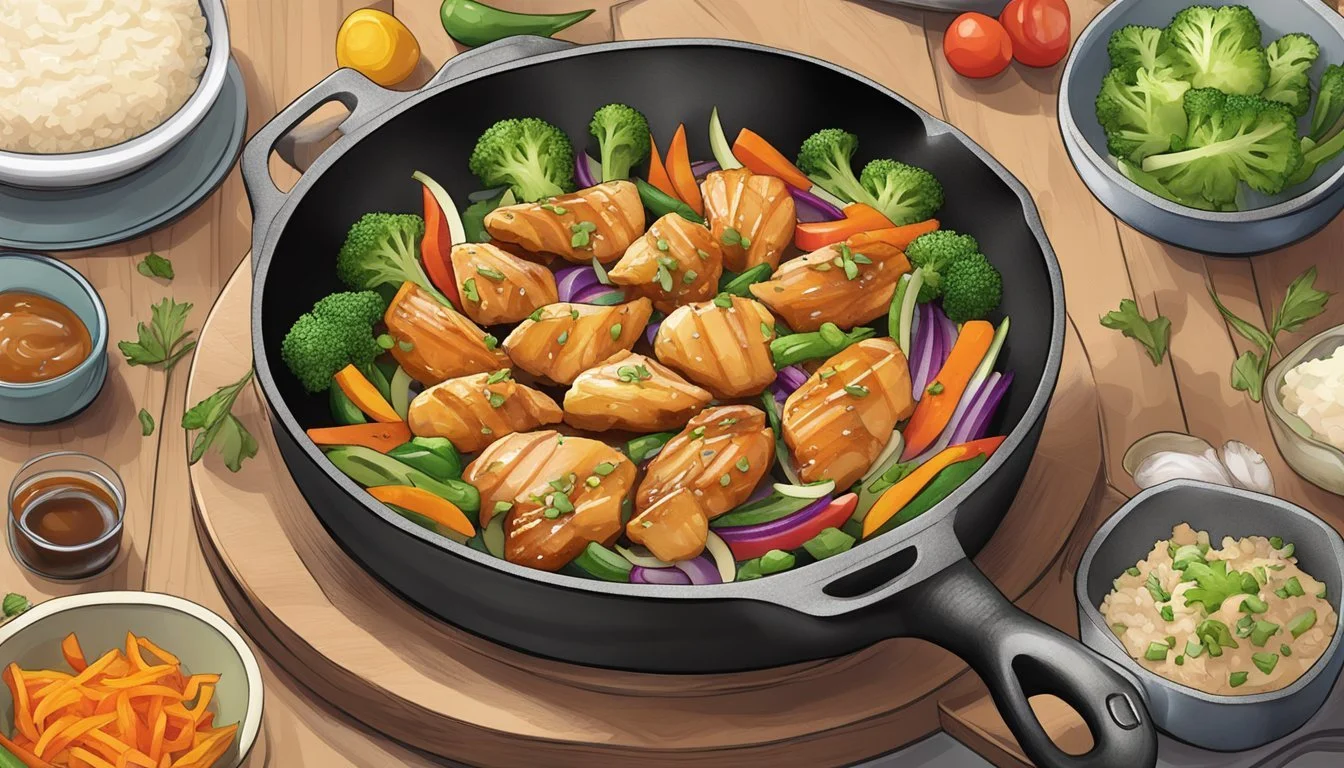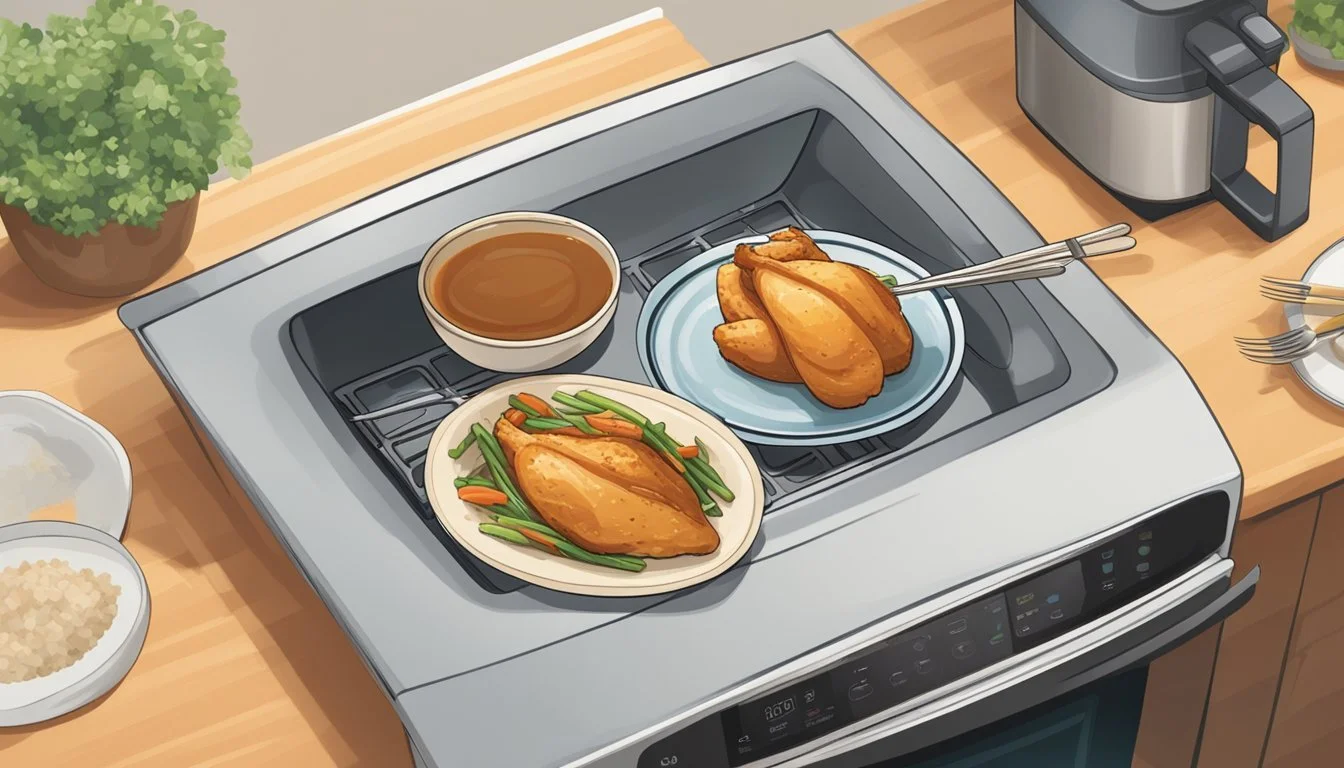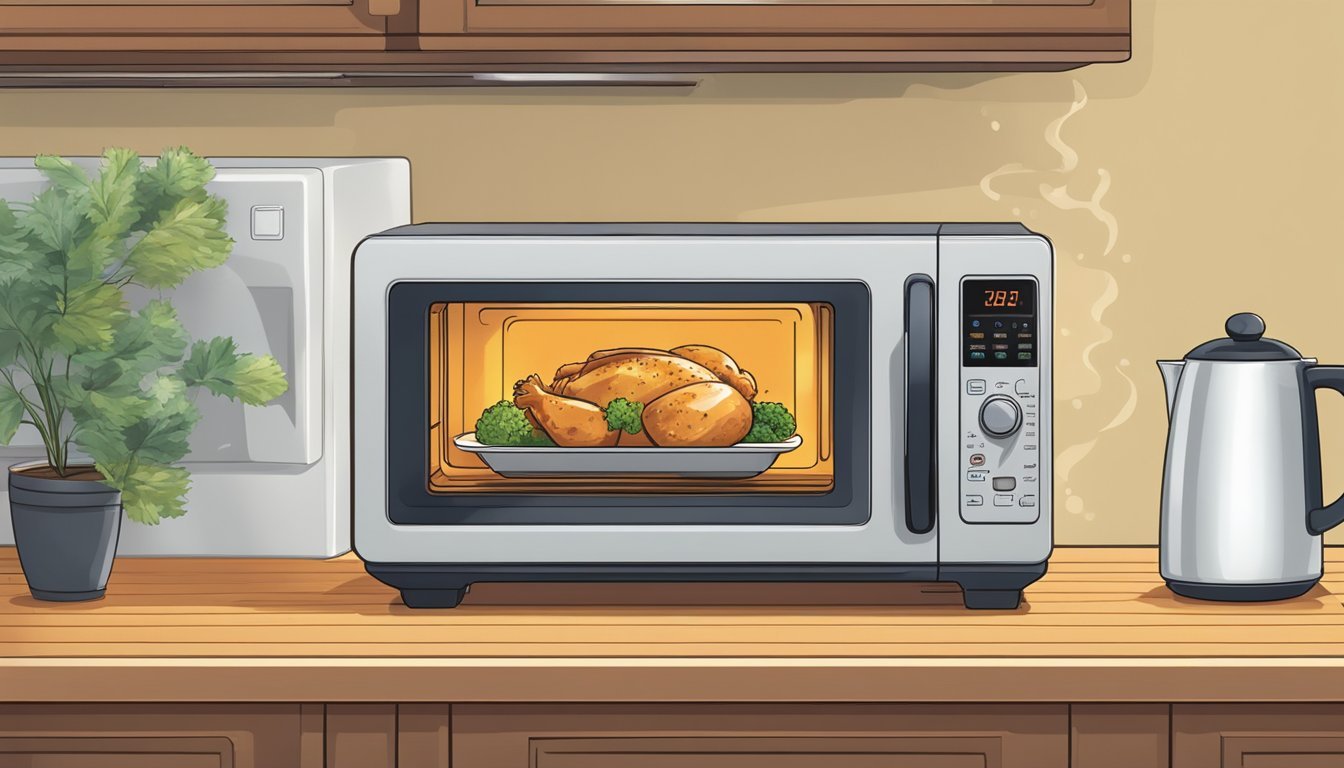How to Reheat Gluten-Free Chicken Teriyaki for Optimal Taste and Texture
Reheating gluten-free chicken teriyaki without losing its delicious flavor and texture can elevate your leftover meal experience. For the best results, reheat the chicken and sauce either in the microwave for 1-2 minutes or on the stove over medium heat, ensuring they stay moist and tasty. These methods help keep the meal quick and easy, perfect for a healthy, hassle-free dinner.
Gluten-free chicken teriyaki is a popular choice for those wanting a clean and nutritious meal. Whether stored for meal prep or as leftovers, it retains its appeal when reheated properly. Knowing the right techniques will ensure you continue to enjoy this dish even on your busiest nights.
Maintaining the quality of gluten-free chicken teriyaki is crucial, especially since gluten-free ingredients can sometimes lose their texture and flavor more easily. By using these simple reheating methods, anyone can enjoy a satisfying and delicious gluten-free dinner.
Understanding Gluten-Free Chicken Teriyaki
Gluten-free chicken teriyaki is a versatile dish that provides a flavorful alternative for those avoiding gluten. Key elements include the choice of chicken, gluten-free ingredients, and the health benefits associated with this dish.
Essential Ingredients
Choosing the right parts of the chicken greatly impacts the dish's texture and flavor. Chicken breast provides a leaner option with fewer calories, suitable for those mindful of their diet. Chicken thighs, on the other hand, offer a richer taste due to their higher fat content.
The teriyaki sauce typically includes soy sauce, but for a gluten-free version, substitutes like tamari or gluten-free soy sauce are essential. Some recipes also use coconut aminos, which is a soy-free alternative. To enhance the taste, common additions are ginger, garlic, and sweeteners like honey or brown sugar.
Gluten-Free Alternatives
When adapting traditional teriyaki recipes, replacing soy sauce with gluten-free soy sauce or tamari is crucial to keep the dish gluten-free. Coconut aminos are also a popular choice, providing a similar umami flavor without soy. These alternatives ensure that the dish remains safe for those with gluten sensitivities or celiac disease.
Thickening agents like cornstarch or arrowroot starch are frequently used instead of wheat-based thickeners. These starches help achieve the desired consistency of the sauce without compromising on the gluten-free requirement.
Health Benefits
Gluten-free chicken teriyaki provides several health benefits. Protein content from chicken helps in muscle repair and growth. Chicken breast is low in saturated fat and cholesterol, making it a heart-healthy choice. On the other hand, chicken thighs provide more iron and zinc, essential for immune function.
Replacing traditional ingredients with gluten-free alternatives ensures the dish is safe for those with gluten intolerances, without losing the authentic taste. The use of ingredients like ginger and garlic also add nutritional value, offering anti-inflammatory and antioxidant properties.
Using tamari or coconut aminos can reduce sodium content compared to regular soy sauce, making it a healthier option for managing blood pressure.
Preparing Your Chicken Teriyaki
Creating a satisfying gluten-free chicken teriyaki involves marinating your chicken to infuse flavors, grilling or baking with the right techniques, and making a rich, flavorful sauce.
Marinating the Chicken
To achieve a flavorful chicken, marinating is essential. Start by making a marinade with soy sauce (ensure it's gluten-free, like tamari), garlic paste, ginger paste, and rice vinegar. Add honey to balance the saltiness and provide a subtle sweetness. Combine all these ingredients in a bowl.
Next, place the chicken pieces in a large ziploc bag. Pour half of the marinade into the bag, ensuring the chicken is fully coated. Close the bag, removing excess air, and place it in the refrigerator. Allow the chicken to marinate for at least 15 minutes, but ideally up to 1 hour, to let the flavors penetrate deeply. This process makes the end result more flavorful and juicy.
Grilling or Baking Tips
When grilling or baking the chicken, preheating is key. For grilling, heat the grill to medium-high. If baking, preheat the oven to 375°F (190°C). Lightly brush the grill grate or baking sheet with olive oil to prevent sticking.
Place the chicken on the grill or baking sheet, ensuring even spacing for proper cooking. Grill or bake the chicken, flipping halfway through the cooking time. The internal temperature should reach at least 160°F (71°C) before removing it from the heat. This usually takes about 7-10 minutes per side for thicker cuts. For additional flavor and color, you can brush the chicken with the reserved marinade during the last few minutes of cooking.
Making the Sauce
To prepare the teriyaki sauce, start by mixing tamari, garlic paste, ginger paste, rice vinegar, and honey in a small saucepan. Bring to a gentle simmer over low-medium heat. In a separate bowl, create a slurry by mixing cornstarch or arrowroot starch with water. Gradually add this slurry to the simmering sauce, whisking continuously.
Continue to cook the sauce, stirring constantly until it thickens. Once thickened, remove from heat. For extra depth, you can sprinkle sesame seeds into the sauce. Finally, pour the sauce over the cooked chicken and toss to coat evenly. This will enhance the dish's flavor and ensure each bite is delicious.
Reheating Techniques
Reheating gluten-free chicken teriyaki requires careful attention to maintain its flavor and moisture. Below are specific methods to reheat this dish using an oven, microwave, or stovetop.
Using the Oven
To reheat gluten-free chicken teriyaki in the oven, start by preheating the oven to 350°F (175°C). Place the chicken in an oven-safe dish, and cover it with aluminum foil to retain moisture.
Instructions:
Preheat Oven: Set to 350°F (175°C).
Prepare Dish: Place chicken in an oven-safe dish and cover with foil.
Heat: Bake for 20-30 minutes until the internal temperature reaches 165°F (74°C).
Regularly check the chicken to avoid overcooking. This method keeps the chicken moist and flavorful.
Microwave Method
For reheating in the microwave, place the chicken on a microwave-safe plate. Set the microwave to medium power to heat evenly without drying out the chicken.
Instructions:
Prepare Plate: Place chicken on a microwave-safe plate.
Heat: Microwave on medium power for 1-2 minutes per piece.
Rotate and Flip: Rotate and flip the chicken halfway through to ensure even heating.
Check Temperature: Ensure the internal temperature reaches 165°F (74°C) using a food thermometer.
Using the microwave is quick and convenient, especially for small portions, but it's essential to avoid overheating.
Stovetop Reheating
Use a skillet for stovetop reheating to achieve a slightly crisp exterior and warm interior. Heat a non-stick skillet over medium heat with a drizzle of oil.
Instructions:
Heat Oil: Use a non-stick skillet and heat over medium with a drizzle of oil.
Add Chicken: Place chicken teriyaki in the skillet.
Cook: Heat for 2-3 minutes per side, or until warmed through.
Optional Sauce: Add some teriyaki sauce and simmer for an additional minute.
Stovetop reheating keeps the chicken juicy and adds a fresh, warm flavor, ideal for maintaining the dish's quality.
Serving Suggestions
Reheating gluten-free chicken teriyaki can be elevated with thoughtful side dishes and presentation ideas to enhance both flavor and visual appeal.
Accompanying Sides
A well-chosen side dish can complement and balance the flavors of gluten-free chicken teriyaki. White rice is a classic pairing, offering a neutral base that allows the teriyaki sauce to shine. Cauliflower rice is a low-carb alternative for those looking to lighten the meal. Vegetables such as steamed broccoli and carrots add a fresh and healthful element. These vegetables can be seasoned with a touch of sesame oil for added depth. Green onions or spring onions can also be sprinkled on top for a burst of flavor and color.
Plating Tips
When it comes to plating, presenting gluten-free chicken teriyaki with artistry speaks volumes. Arrange the chicken slices neatly over a bed of rice or vegetables. Drizzle some extra teriyaki sauce over the top and around the plate for a polished look. Garnish with sesame seeds and finely chopped spring onions to add texture and contrast. For a more vibrant appearance, position the steamed vegetables alongside or slightly overlapping the chicken. These small touches can make the dish visually appealing and appetizing.
Diverse Dietary Considerations
Catering to diverse dietary needs can enhance the versatility and appeal of gluten-free chicken teriyaki. Adjustments for different proteins, vegetarian and vegan preferences, and allergy concerns are critical for inclusive meal planning.
Substituting Proteins
Choice of Protein
Chicken teriyaki can be made with chicken breast, chicken thighs, beef, or salmon. Each protein brings a unique flavor and texture to the dish. Chicken breasts offer a leaner option, while thighs provide a juicier bite.
Cooking Tips
When using chicken thighs or breasts, ensure they are cooked to an internal temperature of 165°F (74°C). For salmon, cook until it flakes easily with a fork, approximately 145°F (63°C). Beef should be cooked based on cut; thinner cuts are typically seared while thicker ones might require longer cooking time.
Vegetarian and Vegan Options
Plant-Based Proteins
Substitute animal proteins with tofu or tempeh for a vegetarian or vegan version. Tofu, particularly firm or extra-firm types, should be pressed to remove excess moisture before cooking. Tempeh offers a nutty flavor and heartier texture.
Cooking Methods
Marinate tofu or tempeh in gluten-free teriyaki sauce for at least 30 minutes. Cook tofu by pan-frying until golden brown on all sides. Tempeh can be steamed briefly before marinating to remove any bitterness, then sautéed until crispy.
Allergy-Friendly Adjustments
Gluten-Free Ingredients
Ensure all ingredients, including soy sauce, are certified gluten-free. Tamari or gluten-free soy sauce is a perfect alternative. Verify that other components of the dish, such as cornstarch, are free from gluten-containing additives.
Other Common Allergies
For those with soy allergies, coconut aminos can replace soy sauce. Peanut allergies can be managed by avoiding recipes that include nuts or by substituting with seeds, such as sunflower or pumpkin seeds.
Customization
For a dairy-free version, exclude any butter if the original recipe calls for it. Opt for vegetable oil or other plant-based oils instead.
By accommodating dietary requirements, gluten-free chicken teriyaki can be enjoyed by everyone.
Additional Tips and Tricks
Use the Right Container
For microwaving, use a microwave-safe plate or bowl. An oven-safe dish is essential for reheating in the oven.
Preheat Your Equipment
Preheating an air fryer or oven can help achieve even heating. Set the air fryer to 400°F (200°C) or the oven to 350°F (175°C).
Avoid Overcooking
Keep an eye on the chicken to avoid drying it out. Reheat only until it reaches an internal temperature of 165°F (74°C).
Moisture Maintenance
To prevent the chicken from drying out, place a damp paper towel over it when reheating in the microwave.
Even Heating
Shake the basket occasionally when using an air fryer. Stir or rotate the chicken halfway through any reheating method.
Quick Reheating
For a fast method, use the microwave. It usually takes just 1-2 minutes per piece of chicken.
Instant Pot Friendly
The Instant Pot can speed up the reheating process. Use the sauté function with some extra teriyaki sauce to keep the chicken moist.
Adding Sauce
If the chicken appears dry, add a bit more teriyaki sauce before reheating. This can help retain moisture and enhance flavor.
Healthy Choices
Use gluten-free ingredients and avoid processed options to keep the meal healthy.
Let It Rest
After reheating, let the chicken rest for a few minutes before serving. This allows the juices to redistribute, enhancing the flavor.
Following these tips can make reheating gluten-free chicken teriyaki an easy, quick task, perfect for a delicious dinner in under 30 minutes.
Expanding Your Gluten-Free Palette
Diversifying one's gluten-free meals can bring a delightful variety to everyday dining. By experimenting with different flavors and incorporating global cuisines, anyone can enjoy deliciously varied gluten-free dinners.
Experimenting with Flavors
Introducing new flavors can significantly enhance the enjoyment of gluten-free meals. Asian-inspired ingredients such as minced garlic, ginger, and black pepper can elevate the taste profile of chicken teriyaki. Chili flakes or red pepper flakes add a spicy kick.
For a touch of sweetness, maple syrup or apple cider vinegar can be used as gluten-free alternatives to traditional sauces. Experimenting with these can transform simple dishes into exciting and flavorful experiences, making gluten-free dinners more appealing.
Incorporating Global Cuisine
Diverse cuisines can offer an array of gluten-free options. For instance, Japanese dishes often utilize simple, naturally gluten-free ingredients. Incorporating elements like miso, tamari (gluten-free soy sauce), and fresh fish can bring new flavors to the table.
Chinese cuisine offers dishes like orange chicken and stir-fries using gluten-free sauces. By exploring global cuisine, individuals can infuse their meals with variety, ensuring that gluten-free dining remains both enjoyable and nutritious.






